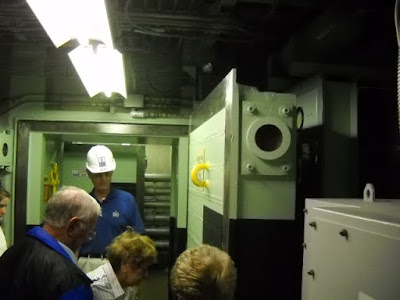
This is the RV (re-entry vehicle) of the Titan II missile. That means it carries the nuclear bomb that is fired into space, then re-enters our atmosphere to hit its target. We were told that if one of these had been aimed at Tucson, it would have destroyed everything from El Paso, TX, to San Diego, CA. WOW! Thank God we never had to actually fire one of these ICBMs (Inter-Continental Ballistic Missiles), because they would have only been fired if we had come under nuclear attack.

At one time, there were 1,000 missile silos in our country, armed with Atlas, Titan I and Titan II missiles. There were 54 Titan II sites around Tucson, AZ, Little Rock, AR, and Wichita, KS. This site in Green Valley is the only one still open. It contains a missile that was built by Martin in LIttleton, CO. It was never armed or fueled. It's sole purpose was to be used for training. This is what it looks like from the top, looking through a glass cover on the silo.

These pictures show the two stages of rockets that shot the missile into space.


This silo was built in 1963 and deactivated in 1982. The silos were stripped and the covers opened half-way. Large concrete blocks were placed so the covers could not be opened all the way. Following that action, the Soviet Union flew over each site to determine that is was no longer in use. Obviously, the same thing was going on in that country, with the U.S. doing the inspection flights. This happened in 1982 after a nuclear reduction treaty had been signed and ratified. The other US silos were all dismantled and back filled. This site was the only one kept open as a museum. This is what the concrete block that stops the cover looks like.

When the site was in operation, these scoop-like devices sent radar beams around the silo. Whenever anything crossed that beam, an alarm sounded and the security forces came to investigate. This is called a tipsy (I think).

The construction of the silo is amazing. Because of the force that would result from firing the rocket out of its hole in the ground, and to protect the rocket from nuclear attack, everything inside the silo "floats." That means lights are mounted on springs.

So is the command center.

Electrical wiring is extra long to prevent wires pulling out when the room moves.

This is one of the interior blast doors, built of steel and concrete.

To assure that no crew member could disrupt operations or fire a missile without an order of the President, all operational areas were "No Lone Zones." That means there had to be two people in those areas, within sight of one another, at all times. Today, that might be a good idea in all air traffic control towers, as well.

It is hard to realize how much technology has changed since the 1960s. Just look at this control panel. It was built with vacuum tubes!

And this was the "print out" of codes entered into the equipment.

Our tour guide, Jim, had a woman sit in the commander's seat at the control panel. He said he always did this because, once women were allowed to serve in some combat positions in the armed services, the Titan II program was one of the first places they were assigned.

Every person on the silo tour over 5 feet 10 inches tall had to wear a hard hat because in many places there were low-hanging items. Doesn't John look good in his blue hat?

John grew up in Castle Rock, CO. His father owned the ambulance service that responded to all medical emergencies in two counties. A Titan I missile silo was located 17 miles east of Castle Rock, just outside of Elizabeth. The federal government contracted with John's dad to provide ambulance coverage in case of a medical emergency or accident. The silo was operated in such a safe manner that they never had to respond on an emergency call.

Ron actually did work on the Titan II guidance system. It's hard to imagine how they could be accurate.
ReplyDelete